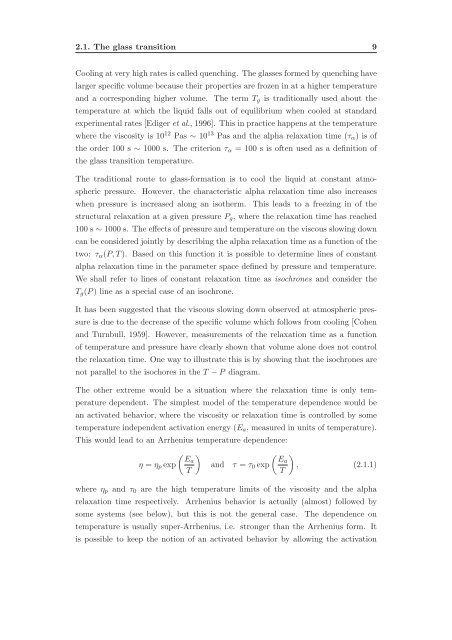Ph.D. thesis (pdf) - dirac
Ph.D. thesis (pdf) - dirac
Ph.D. thesis (pdf) - dirac
Create successful ePaper yourself
Turn your PDF publications into a flip-book with our unique Google optimized e-Paper software.
2.1. The glass transition 9<br />
Cooling at very high rates is called quenching. The glasses formed by quenching have<br />
larger specific volume because their properties are frozen in at a higher temperature<br />
and a corresponding higher volume. The term T g is traditionally used about the<br />
temperature at which the liquid falls out of equilibrium when cooled at standard<br />
experimental rates [Ediger et al., 1996]. This in practice happens at the temperature<br />
where the viscosity is 10 12 Pas ∼ 10 13 Pas and the alpha relaxation time (τ α ) is of<br />
the order 100 s ∼ 1000 s. The criterion τ α = 100 s is often used as a definition of<br />
the glass transition temperature.<br />
The traditional route to glass-formation is to cool the liquid at constant atmospheric<br />
pressure. However, the characteristic alpha relaxation time also increases<br />
when pressure is increased along an isotherm. This leads to a freezing in of the<br />
structural relaxation at a given pressure P g , where the relaxation time has reached<br />
100 s ∼ 1000 s. The effects of pressure and temperature on the viscous slowing down<br />
can be considered jointly by describing the alpha relaxation time as a function of the<br />
two: τ α (P, T). Based on this function it is possible to determine lines of constant<br />
alpha relaxation time in the parameter space defined by pressure and temperature.<br />
We shall refer to lines of constant relaxation time as isochrones and consider the<br />
T g (P) line as a special case of an isochrone.<br />
It has been suggested that the viscous slowing down observed at atmospheric pressure<br />
is due to the decrease of the specific volume which follows from cooling [Cohen<br />
and Turnbull, 1959]. However, measurements of the relaxation time as a function<br />
of temperature and pressure have clearly shown that volume alone does not control<br />
the relaxation time. One way to illustrate this is by showing that the isochrones are<br />
not parallel to the isochores in the T − P diagram.<br />
The other extreme would be a situation where the relaxation time is only temperature<br />
dependent. The simplest model of the temperature dependence would be<br />
an activated behavior, where the viscosity or relaxation time is controlled by some<br />
temperature independent activation energy (E a , measured in units of temperature).<br />
This would lead to an Arrhenius temperature dependence:<br />
η = η p exp<br />
(<br />
Ea<br />
T<br />
)<br />
and<br />
τ = τ 0 exp<br />
(<br />
Ea<br />
T<br />
)<br />
, (2.1.1)<br />
where η p and τ 0 are the high temperature limits of the viscosity and the alpha<br />
relaxation time respectively. Arrhenius behavior is actually (almost) followed by<br />
some systems (see below), but this is not the general case. The dependence on<br />
temperature is usually super-Arrhenius, i.e. stronger than the Arrhenius form. It<br />
is possible to keep the notion of an activated behavior by allowing the activation

















